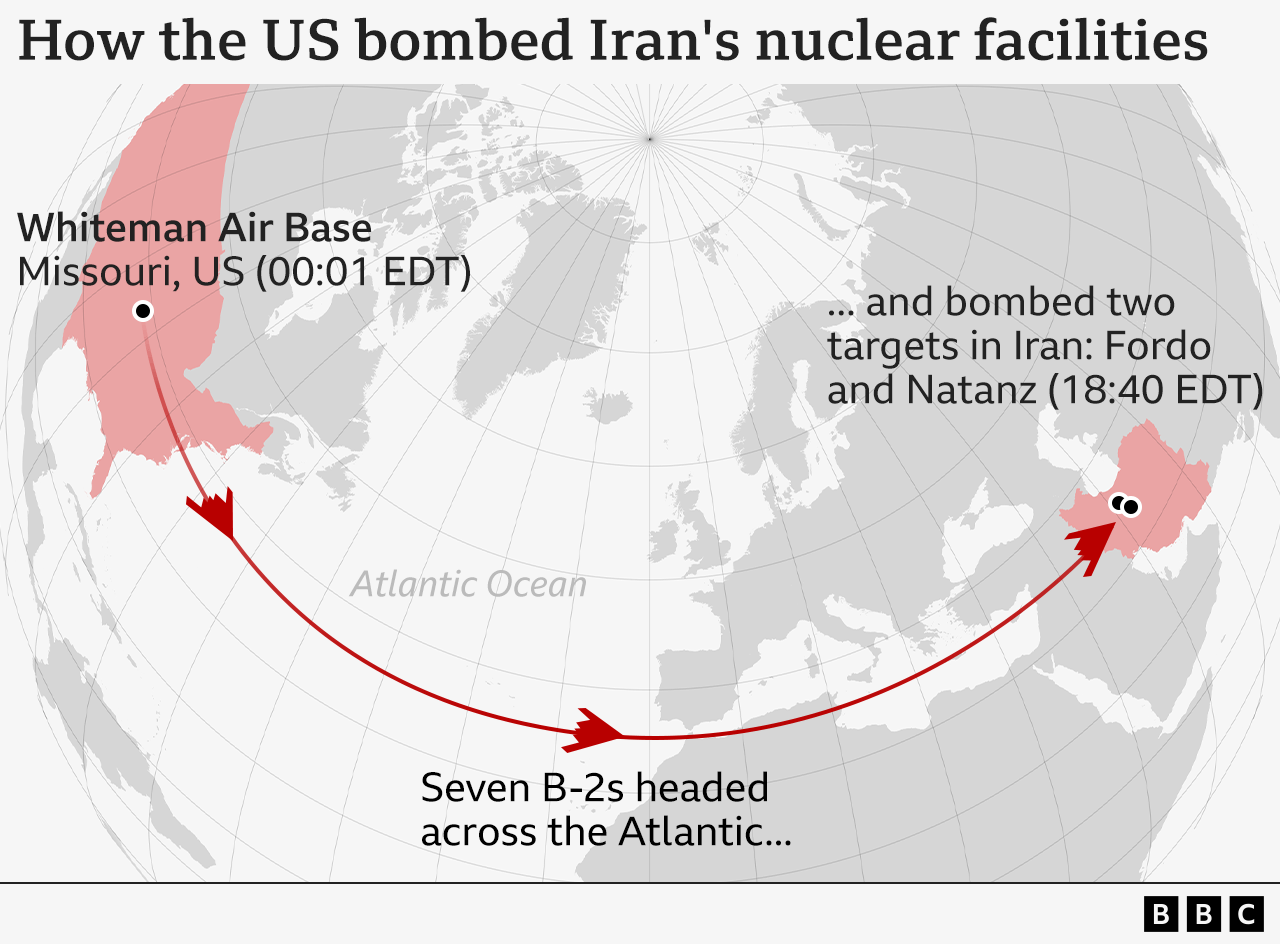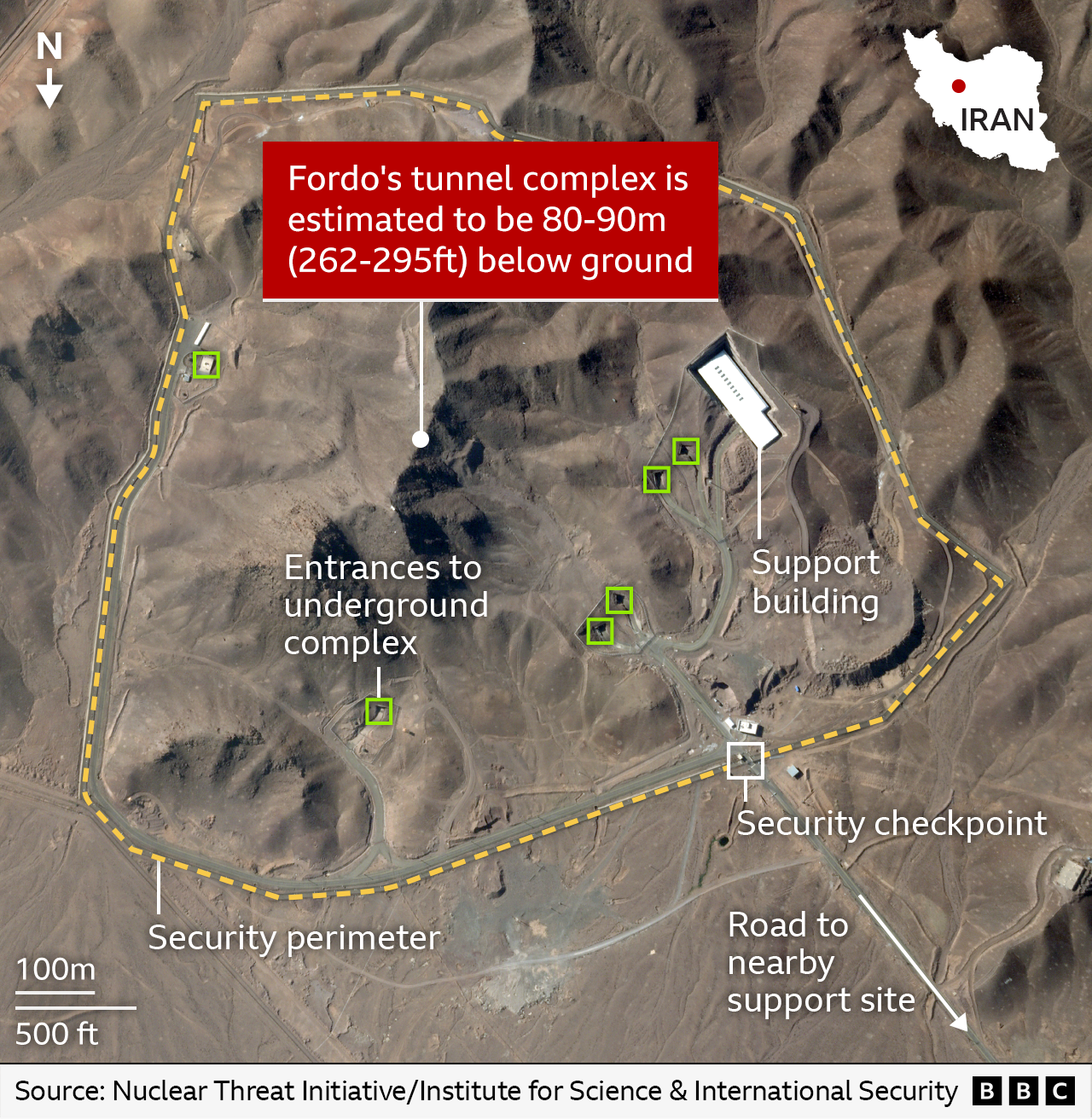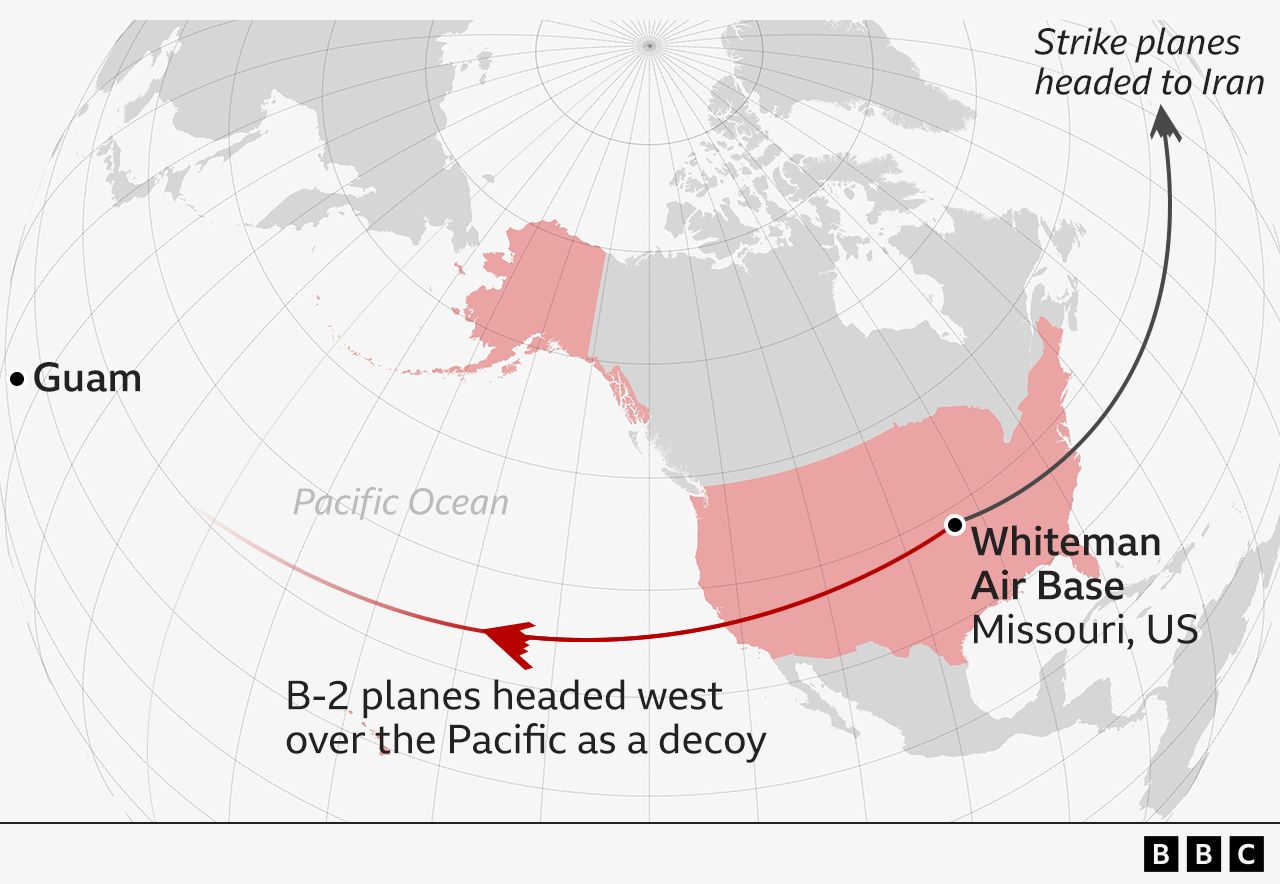Decoy flights and seven B-2 stealth bombers - how US says it hit Iran's nuclear sites

- Published
An 18-hour flight each way, multiple mid-air refuelings, and a series of decoys - this is how the mission to bomb Iran's nuclear facilities played out, according to four-star General Dan Caine, the Chairman of the Joint Chiefs of Staff, the highest-ranking officer in the US military.
Although the full impact of what the US is calling 'Operation Midnight Hammer' is still unclear, a timeline of how the complex mission unfolded was laid out in a Pentagon briefing on Sunday morning, mere hours after the strikes.
American bombers went "in and out and back without the world knowing at all", US Secretary of Defense Pete Hegseth told reporters.

It all began just after midnight when Secretary Hegseth joined US President Donald Trump, Vice-President JD Vance, Secretary of State Marco Rubio, and elite Pentagon staff in the Situation Room at the White House to watch as a fleet of aircraft departed an American airbase in rural Missouri.
Under the cover of darkness, B-2 stealth bombers took off from Whiteman Air Force Base at 00:01 EDT (05:01 BST), according to the Pentagon.
Their ultimate target: Iran's most secure nuclear sites.
The subsonic jets, which travel just below the speed of sound, flew over the Atlantic Ocean loaded with powerful "bunker buster" bombs capable of penetrating concrete over 18m (60ft) deep.
It's the kind of weaponry needed to hit Iran's nuclear enrichment facility at Fordo, which is buried below a mountain deep underground and considered to be the epicentre of the country's nuclear programme. The US is the only country in the world known to possess this type of weapon.

But the world wasn't watching - yet. All eyes were facing west, towards the Pacific Ocean, following reports bombers had been sent to the US island territory of Guam.
"While the deployment is not being officially connected to discussions around the US joining Israel's war on Iran, few will doubt the link," the BBC wrote at the time.
But it was just a ruse - according to the account delivered by the Pentagon - a decoy to distract from the top-secret flights heading straight for Iran over the Atlantic.

The planes that flew west over the Pacific were "a deception effort known only to an extremely small number of planners and key leaders," Gen Caine said.
"The main strike package comprised of seven B-2 spirit bombers, each with two crew members, proceeded quietly to the east with minimal communications," he added.
Those military planes don't show up on flight tracking websites, making it difficult for the BBC to independently verify the Pentagon's description of the events.
And although satellite images can help show the extent of damage at the sites overnight, they can't tell us the exact times when they were hit.
When the fleet made it to the Middle East, sometime around 17:00 EDT (22:00 BST), it was joined by support aircraft that helped protect the bombers by sweeping in front of them to look for enemy fighters and surface-to-air missile threats, in what Gen Caine called a "complex, tightly timed manoeuvre".
But Iranian fighter jets didn't take off and no air defences appeared to fire a shot, according to US officials.
"Israeli dominance over Iranian airspace primed the pump for American bombers to operate with impunity," Patrycja Bazylczyk, a missile defence expert at the Center for Strategic and International Studies in Washington DC, told BBC Verify.
The next hour and forty minutes were described by Gen Caine during the Pentagon briefing in a level of detail not normally disclosed to the public.
Although the briefing provided timings for certain events, the map showing the bombers' journey wasn't a specific flight path and differed slightly in two versions presented.
The Trump administration has proclaimed the subsequent events as a total victory, claiming the US had "obliterated" Iran's nuclear regime. But the true extent of the damage, and its aftermath, has yet to be measured.
While Iran has confirmed the attacks, it has minimised the extent of the damage and has not provided a specific account of the sequence of events.
At around 17:00 EDT (22:00 BST) US officials say more than two dozen Tomahawk land attack cruise missiles were launched from a US submarine stationed in the Arabian Sea towards the nuclear site near Isfahan, a city of about two million people.
While the nuclear facility there is hundreds of kilometres inland, the submarines were close enough to enable the cruise missiles to impact at roughly the same time as the stealthy B-2s dropped their "bunker buster" bombs over the other two nuclear sites, said Dr Stacie Pettyjohn, a defence expert at the Center for a New American Security.
It all meant that the US was able to provide "a coordinated surprise attack on multiple sites", she told BBC Verify.
Meanwhile, the fleet of bombers entered Iranian airspace, where the US employed several other deception tactics, including more decoys, according to the Pentagon.
Then the air strikes began.

The lead bomber dropped two GBU-57 Massive Ordnance Penetrator weapons - known as MOPs - on the first of several targets at Fordo at about 18:40 EDT (23:40 BST), just after 02:00 in the morning in Iran.
The MOP bomb is able to drop through about 18m (60ft) of concrete or 61m (200ft) of earth before exploding, according to experts. This means that although it's not guaranteed success, it is the only bomb in the world that could come close to impacting the depth of tunnels at the Fordo facility - thought to be 80-90m (262-295ft) below the surface.
It was the first time the "bunker buster" bombs were ever dropped in a real combat operation.
The remaining bombers then hit their targets - with a total of 14 MOPs dropped on Fordo and a second nuclear facility at Natanz, according to the Pentagon. And at the Isfahan nuclear site, over 200km away from Fordo, the Tomahawk missiles hit their targets.
After the planes spent 18 hours in the air, all the targets were hit in just about 25 minutes before they exited Iran at 19:30 EDT (00:30 BST) to return to the US, according to the Pentagon.
In total, about 75 precision guided weapons and more than 125 US aircraft were used, and Secretary Hegseth claimed the mission provided "powerful and clear" destruction of Iran's nuclear capabilities.
But evidence of the full scope of the strikes will take time to assess - with more footage needed to see how deep underground the bunker buster bombs were able to penetrate at the key nuclear sites.
"This was an incredibly complicated and very sophisticated attack that no other country in the world could have performed," Dr Pettyjohn said.
"Despite the success of the operation tactically, it is unclear if it will achieve the goal of permanently setting back Iran's nuclear program."
